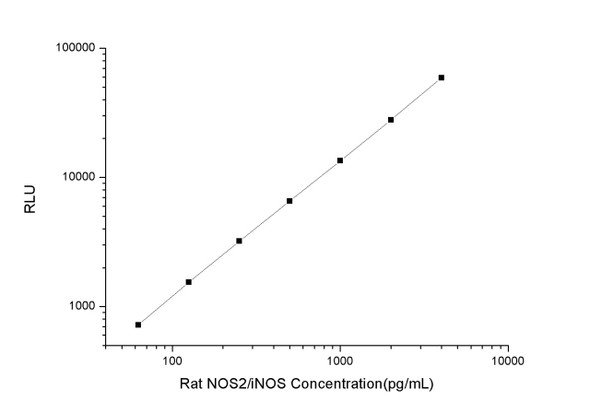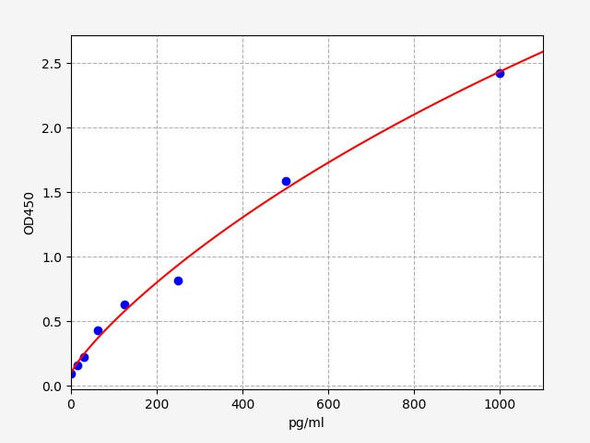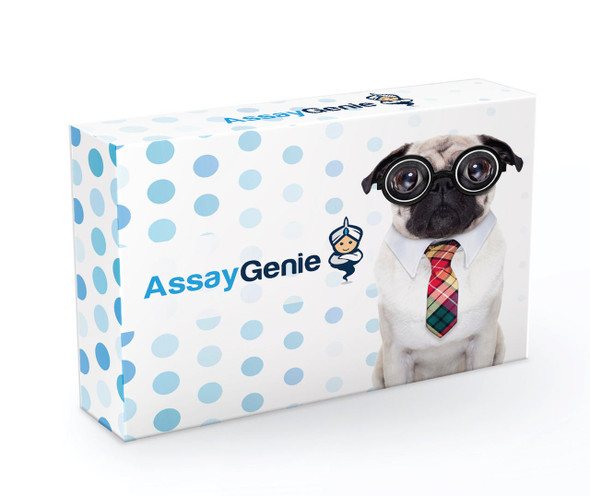Mouse Cell Signalling ELISA Kits 2
Mouse NOS2/iNOS (Nitric Oxide Synthase 2, Inducible) CLIA Kit (MOES00381)
- SKU:
- MOES00381
- Product Type:
- ELISA Kit
- ELISA Type:
- CLIA Kit
- Size:
- 96 Assays
- Sensitivity:
- 37.5pg/mL
- Range:
- 62.5-4000pg/mL
- ELISA Type:
- Sandwich
- Synonyms:
- NOS2A, HEP-NOS, I-NOS
- Reactivity:
- Mouse
- Sample Type:
- Serum, plasma and other biological fluids
Description
| Assay type: | Sandwich |
| Format: | 96T |
| Assay time: | 4.5h |
| Reactivity: | Mouse |
| Detection method: | Chemiluminescence |
| Detection range: | 62.50-4000 pg/mL |
| Sensitivity: | 37.50 pg/mL |
| Sample volume: | 100µL |
| Sample type: | Serum, plasma and other biological fluids |
| Repeatability: | CV < 15% |
| Specificity: | This kit recognizes Mouse NOS2/iNOS in samples. No significant cross-reactivity or interference between Mouse NOS2/iNOS and analogues was observed. |
This kit uses Sandwich-CLIA as the method. The micro CLIA plate provided in this kit has been pre-coated with an antibody specific to Mouse NOS2/iNOS. Standards or samples are added to the appropriate micro CLIA plate wells and combined with the specific antibody. Then a biotinylated detection antibody specific for Mouse NOS2/iNOS and Avidin-Horseradish Peroxidase (HRP) conjugate are added to each micro plate well successively and incubated. Free components are washed away. The substrate solution is added to each well. Only those wells that contain Mouse NOS2/iNOS, biotinylated detection antibody and Avidin-HRP conjugate will appear fluorescence. The Relative light unit (RLU) value is measured spectrophotometrically by the Chemiluminescence immunoassay analyzer. The RLU value is positively associated with the concentration of Mouse NOS2/iNOS. The concentration of Mouse NOS2/iNOS in the samples can be calculated by comparing the RLU of the samples to the standard curve.
| UniProt Protein Function: | Produces nitric oxide (NO) which is a messenger molecule with diverse functions throughout the body (PubMed:7503239). In macrophages, NO mediates tumoricidal and bactericidal actions. Also has nitrosylase activity and mediates cysteine S-nitrosylation of cytoplasmic target proteins such PTGS2/COX2 (PubMed:16373578). As component of the iNOS-S100A8/9 transnitrosylase complex involved in the selective inflammatory stimulus-dependent S-nitrosylation of GAPDH implicated in regulation of the GAIT complex activity and probably multiple targets including ANXA5, EZR, MSN and VIM. Involved in inflammation, enhances the synthesis of proinflammatory mediators such as IL6 and IL8. |
| NCBI Summary: | Nitric oxide is a reactive free radical which acts as a biologic mediator in several processes, including neurotransmission and antimicrobial and antitumoral activities. This gene encodes a nitric oxide synthase that is inducible by a combination of lipopolysaccharide and certain cytokines. Three transcript variants encoding two different isoforms have been found for this gene. [provided by RefSeq, Sep 2015] |
| UniProt Code: | P29477 |
| NCBI GenInfo Identifier: | 266649 |
| NCBI Gene ID: | 18126 |
| NCBI Accession: | P29477. 1 |
| UniProt Secondary Accession: | P29477,O70515, O70516, Q5SXT3, Q6P6A0, Q8R410, |
| UniProt Related Accession: | P29477 |
| Molecular Weight: | 130,575 Da |
| NCBI Full Name: | Nitric oxide synthase, inducible |
| NCBI Synonym Full Names: | nitric oxide synthase 2, inducible |
| NCBI Official Symbol: | Nos2 |
| NCBI Official Synonym Symbols: | iNOS; Nos-2; Nos2a; i-NOS; NOS-II; MAC-NOS |
| NCBI Protein Information: | nitric oxide synthase, inducible |
| UniProt Protein Name: | Nitric oxide synthase, inducible |
| UniProt Synonym Protein Names: | Inducible NO synthase; Inducible NOS; iNOS; Macrophage NOS; MAC-NOS; NOS type II; Peptidyl-cysteine S-nitrosylase NOS2 |
| Protein Family: | Inositol 3-kinase |
| UniProt Gene Name: | Nos2 |
As the RLU values of the standard curve may vary according to the conditions of the actual assay performance (e. g. operator, pipetting technique, washing technique or temperature effects), the operator should establish a standard curve for each test. Typical standard curve and data is provided below for reference only.
| Concentration (pg/mL) | RLU | Average | Corrected |
| 4000 | 55607 62555 | 59081 | 59046 |
| 2000 | 26106 29612 | 27859 | 27824 |
| 1000 | 14583 12385 | 13484 | 13449 |
| 500 | 6573 6637 | 6605 | 6570 |
| 250 | 3299 3187 | 3243 | 3208 |
| 125 | 1636 1526 | 1581 | 1546 |
| 62.50 | 727 783 | 755 | 720 |
| 0 | 35 35 | 35 | -- |
Precision
Intra-assay Precision (Precision within an assay): 3 samples with low, mid range and high level Mouse NOS2/iNOS were tested 20 times on one plate, respectively.
Inter-assay Precision (Precision between assays): 3 samples with low, mid range and high level Mouse NOS2/iNOS were tested on 3 different plates, 20 replicates in each plate.
| Intra-assay Precision | Inter-assay Precision | |||||
| Sample | 1 | 2 | 3 | 1 | 2 | 3 |
| n | 20 | 20 | 20 | 20 | 20 | 20 |
| Mean (pg/mL) | 213.23 | 560.81 | 1523.99 | 192.81 | 556.72 | 1413.08 |
| Standard deviation | 19.30 | 40.88 | 134.11 | 21.40 | 48.82 | 153.46 |
| C V (%) | 9.05 | 7.29 | 8.80 | 11.10 | 8.77 | 10.86 |
Recovery
The recovery of Mouse NOS2/iNOS spiked at three different levels in samples throughout the range of the assay was evaluated in various matrices.
| Sample Type | Range (%) | Average Recovery (%) |
| Serum (n=5) | 88-102 | 95 |
| EDTA plasma (n=5) | 89-102 | 96 |
| Cell culture media (n=5) | 90-104 | 96 |
Linearity
Samples were spiked with high concentrations of Mouse NOS2/iNOS and diluted with Reference Standard & Sample Diluent to produce samples with values within the range of the assay.
| Serum (n=5) | EDTA plasma (n=5) | Cell culture media (n=5) | ||
| 1:2 | Range (%) | 90-103 | 103-118 | 88-101 |
| Average (%) | 97 | 110 | 94 | |
| 1:4 | Range (%) | 99-116 | 93-104 | 101-117 |
| Average (%) | 107 | 99 | 109 | |
| 1:8 | Range (%) | 97-110 | 89-102 | 98-115 |
| Average (%) | 104 | 96 | 105 | |
| 1:16 | Range (%) | 94-111 | 92-105 | 101-116 |
| Average (%) | 101 | 99 | 109 |
An unopened kit can be stored at 4°C for 1 month. If the kit is not used within 1 month, store the items separately according to the following conditions once the kit is received.
| Item | Specifications | Storage |
| Micro CLIA Plate(Dismountable) | 8 wells ×12 strips | -20°C, 6 months |
| Reference Standard | 2 vials | |
| Concentrated Biotinylated Detection Ab (100×) | 1 vial, 120 µL | |
| Concentrated HRP Conjugate (100×) | 1 vial, 120 µL | -20°C(shading light), 6 months |
| Reference Standard & Sample Diluent | 1 vial, 20 mL | 4°C, 6 months |
| Biotinylated Detection Ab Diluent | 1 vial, 14 mL | |
| HRP Conjugate Diluent | 1 vial, 14 mL | |
| Concentrated Wash Buffer (25×) | 1 vial, 30 mL | |
| Substrate Reagent A | 1 vial, 5 mL | 4°C (shading light) |
| Substrate Reagent B | 1 vial, 5 mL | 4°C (shading light) |
| Plate Sealer | 5 pieces | |
| Product Description | 1 copy | |
| Certificate of Analysis | 1 copy |
- Set standard, test sample and control (zero) wells on the pre-coated plate and record theirpositions. It is recommended to measure each standard and sample in duplicate. Note: addall solutions to the bottom of the plate wells while avoiding contact with the well walls. Ensuresolutions do not foam when adding to the wells.
- Aliquot 100µl of standard solutions into the standard wells.
- Add 100µl of Sample / Standard dilution buffer into the control (zero) well.
- Add 100µl of properly diluted sample (serum, plasma, tissue homogenates and otherbiological fluids. ) into test sample wells.
- Cover the plate with the sealer provided in the kit and incubate for 90 min at 37°C.
- Aspirate the liquid from each well, do not wash. Immediately add 100µL of BiotinylatedDetection Ab working solution to each well. Cover the plate with a plate seal and gently mix. Incubate for 1 hour at 37°C.
- Aspirate or decant the solution from the plate and add 350µL of wash buffer to each welland incubate for 1-2 minutes at room temperature. Aspirate the solution from each well andclap the plate on absorbent filter paper to dry. Repeat this process 3 times. Note: a microplatewasher can be used in this step and other wash steps.
- Add 100µL of HRP Conjugate working solution to each well. Cover with a plate seal andincubate for 30 min at 37°C.
- Aspirate or decant the solution from each well. Repeat the wash process for five times asconducted in step 7.
- Add 100µL of Substrate mixture solution to each well. Cover with a new plate seal andincubate for no more than 5 min at 37°C. Protect the plate from light.
- Determine the RLU value of each well immediately.






